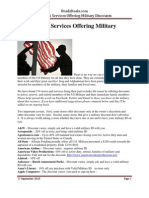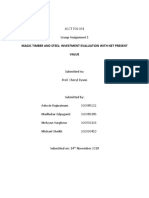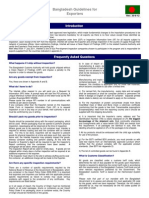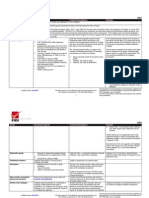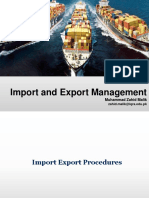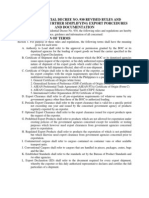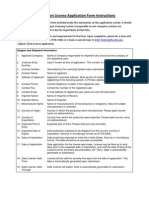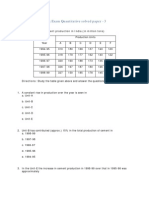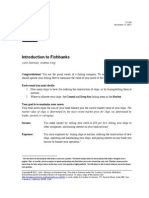CB Exam October-2010
CB Exam October-2010
Uploaded by
David LynchCopyright:
Available Formats
CB Exam October-2010
CB Exam October-2010
Uploaded by
David LynchCopyright
Available Formats
Share this document
Did you find this document useful?
Is this content inappropriate?
Copyright:
Available Formats
CB Exam October-2010
CB Exam October-2010
Uploaded by
David LynchCopyright:
Available Formats
Series 580 October 4, 2010 U.S.
CBP
Test No. 581
Customs Broker License Examination DIRECTIONS - READ CAREFULLY This examination consists of 80 questions. The minimum passing score is 75%. For each question, choose the letter representing your answer (A, B, C, D, or E) and completely darken the corresponding space on your answer sheet. There is no penalty for guessing; therefore, you should attempt to answer every question. Each question is designed to have a single best answer. You are responsible for having the following references: Harmonized Tariff Schedule of the United States (2010) Title 19, Code of Federal Regulations Revised as of April 1, 2009 (Parts 0 to 140, 141 to 199) Customs and Trade Automated Interface Requirements (CATAIR) Appendix B Valid Codes Appendix H Census Warning Messages Appendix D Metric Conversion Appendix L Drawback Errors Appendix E Valid Entry Numbers Glossary of Terms Appendix G Common Errors Instructions for Preparation of CBP Form 7501 (8-30-2005) Submission Changes for Supplemental Information Letters and Post Entry Amendments Remote Location Filing Eligibility Requirements (4-18-2005) Directives 3510-004, Monetary Guidelines for Setting Bond Amounts Clarification to July 9, 2004 Amended Monetary Guidelines for Setting Bond Amounts for Certain Merchandise Subject to Antidumping/Countervailing Duty Cases 3550-055, Instructions for Deriving Manufacturer/Shipper Identification Code 3550-067, Entry Summary Acceptance and Rejection Policy 3550-079A, Ultimate Consignee at time of Entry or Release 3560-001A, Census Interface-Processing Procedures 5610-002A, Standard Guidelines for the Input of Names and Addresses Into Automated Commercial System (ACS) Files
This examination lasts four (4) hours. When you finish, please give your answer sheet to the examiner. You may take this booklet with you. DO NOT TURN THIS PAGE UNTIL TOLD TO DO SO BY THE EXAMINER.
THIS PAGE IS INTENTIONALLY BLANK.
GO TO NEXT PAGE
Customs Broker License Examination
Section 1 - ENTRY
Questions 1 - 22
Section 2 - CLASSIFICATION
Questions 23 - 50
Section 3 - WAREHOUSE
Questions 51 - 56
Section 4 - TRADE AGREEMENTS
Questions 57 - 60
Section 5 FINES PENALTIES & FORFEITURES
Questions 61 - 65
Section 6 - VALUATION
Questions 66 - 71
Section 7 - BROKER COMPLIANCE
Questions 72 - 80
GO TO NEXT PAGE
Section 1: ENTRY
1.
Which article is an exception from the requirements of country of origin marking? A. Screw driver B. Ceramic cups C. Christmas trees D. Paper book E. Plastic picket fence
2.
Entry summaries subject to anti-dumping and/or countervailing duty cases (ABI and nonABI) may be rejected _____ without supervisory approval following the summary filing date. A. Up to 10 business days B. Up to 30 calendar days C. Up to 30 business days D. Up to 60 calendar days E. Up to 90 calendar days
3.
For purposes of determining country of origin, all of the following are considered to be textile or apparel product except: A. 3005.90.1000 B. 6302.51.3000 C. 6406.10.7200 D. 6502.00.4000 E. 6601.10.0000
4. Which form shall be presented to CBP to obtain release of a shipment of pesticides? A. DS form 2031 B. EPA form 3520-1 C. DOT form HS-7 D. EPA form 3540-1 E. FCC form 740
GO TO NEXT PAGE
5.
U.S. Company A places an order with an overseas shipper and then sells the goods to U.S. Company B in a domestic transaction prior to the importation. The invoice issued by the overseas shipper states sold to: U.S. Company A and ship to: U.S. Company B. The consignee on the bill of lading is U.S. Company B. Who is the ultimate consignee for this formal entry? A. The overseas shipper B. The broker C. The carrier D. U.S. Company A E. U.S. Company B
6.
When must a Toxic Substances Control Act (TSCA) certification be filed for a bulk shipment of chemical substances? A. The first business day of the month B. At entry summary C. A TSCA certificate is no longer required for any shipment D. Before release of the shipment E. Anytime after release but before entry summary
7.
Which of the following would satisfy the country of origin marking requirement for an importation of a food product labeled Spanish Tortilla, which is made in Spain and distributed by an importer in Los Angeles, California? A. B. C. D. E. Distributed by Importer, Los Angeles, California Spain Made in Espana Product of the USA Distributed by Importer, Los Angeles, California Product of Spain Spanish Tortillas distributed by Importer, Los Angeles, California
8.
What Federal government entity is responsible for issuing laws and regulations governing merchandise prohibited by economic sanctions? A. Department of State B. Customs & Border Protection C. Office of Foreign Assets Control D. Foreign Claims Settlement Commission E. Department of Commerce
GO TO NEXT PAGE
9.
_____ will establish locations at which exporters must present the required documentation and the vehicles for inspection, and will also publicize these locations, including their hours of operation. A. Supervisory Import Specialists B. Supervisory CBP Officers C. Port Directors D. Supervisory Entry Specialists E. Assistant Directors of Trade
10.
If an importer of record would like to have bills, refunds, and notices of liquidations (including notices of extension or suspension of liquidation) mailed in care of his/her agent, an accepted identification number for the agent should appear in the box labeled _____ on the CBP Form 7501. A. Importer Number B. Broker/Filer Information C. Consignee Number D. Reference Number E. Ultimate Consignee Name and Address
11.
Prior to release of the merchandise under the Temporary Importation Bond (TIB) procedure, the importer must post a bond in the amount of: A. Nothing, it is free of duty. B. The total amount of duties, including fees, which it is estimated would accrue had the articles been entered under an ordinary consumption entry. C. The amount of taxes and fees only based on the Harmonized Tariff Schedule of the U.S. (HTSUS) article description. D. Twice the total amount of duties, including fees, which it is estimated would accrue had the articles been entered under an ordinary consumption entry, or such larger amount as the port director deems necessary. E. $50,000, the minimum amount of a continuous importation bond.
GO TO NEXT PAGE
12. Identify the Manufacturer I.D. using the following information: Colenso Ladysmith Incorporated 222 Schoeman Street Pretoria, South Africa A. COLLADINC222PRE B. COLLAD222PRESA C. COLLAD222SCHSA D. ZACOLLAD222SCH E. ZACOLLAD222PRE
13.
A vessel with foreign cargo consisting of widgets arrived into the United States on Monday, June 1st. On the same day, a broker files CBP Form 7512 to move the freight in bond from Port Everglades to Miami. On June 9th, a bonded carrier picks up the merchandise at Port Everglades. On July 15th, the bonded carrier delivers the merchandise to a bonded are house in Boca Raton. On July 30th, the Transportation and Exportation Entry (T&E) is presented to CBP at the port of West Palm Beach. Based on the above, how many violations have occurred? A. No violations have occurred. B. One violation has occurred. C. Two violations have occurred. D. Three violations have occurred. E. Four violations have occurred.
14.
What CBP form is used for the entry for transportation and exportation for each transfer of merchandise to the Customs territory for transportation to and exportation from a different port? A. 301 B. 3461 C. 3499 D. 7501 E. 7512
GO TO NEXT PAGE
15.
What is the date of entry for goods imported and entered under a Special Permit for Immediate Delivery? A. The date the merchandise is authorized for release by the CBP Officer. B. The date the entry summary (live entry) is filed in proper form. C. The date the entry summary is filed in proper form with estimated duties attached. D. The date the entry documentation is filed if requested by the importer. E. The date the merchandise arrives in the U.S.
16.
Except for certain merchandise covered by an entry for immediate transportation or retained by the carrier and returned to the port of entry, the rates of duty applicable to merchandise shall be those in effect on which date? A. The date of exportation. B. The date of importation. C. The date of entry or withdrawal for consumption. D. The date of clearance by CBP. E. The date of delivery of the merchandise.
17.
What is the International Standard Country Code (ISO Code) for Georgia? A. GA B. GR C. GI D. GE E. US
18.
What is the amount of time an importer identification number remains in CBPs files before it is removed due to inactivity? A. 3 months from the date it was filed with CBP. B. 3 months from the date it was last used on Customs Form 7501 or a request for services. C. 6 months from the date it was filed with CBP. D. 1 year from the date it was last used on Customs Form 7501 or a request for services. E. 12 months from the date it was filed with CBP.
GO TO NEXT PAGE
19.
With the exception of bulk and certain bulk-break cargo, Importer Security Filings (ISF) for Immediate Export (IE) or Transportation and Exportation (T&E) in-bond shipments must be submitted no later than 24 hours _____ via a CBP-approved electronic interchange system. A. Prior to arrival of cargo from a foreign port B. Before cargo is laden aboard the vessel at the foreign port C. After the cargo is laden aboard a vessel destined to the United States D. Prior to departure of a vessel from foreign port E. After departure of a vessel from foreign port
20.
Which of the following is false in regards to construction of the manufacturer identification code (MID)? A. In situations where a single entry is filed for products of more than one manufacturer, the products must be separately identified. B. Ignore all punctuation, such as commas, periods and ampersands. C. If there are two or more initials together, treat them as a single word. D. Use the first two letters from the city name. E. The MID may be up to 15 characters in length.
21.
Which one of the following CBP Forms is for The Declaration of Unaccompanied Articles? A. 255 B. 3461 C. 6043 D. 4647 E. 7501
22.
What is the maximum period of validity from the date of issue for an Admission Temporaire/Temporary Admission (A.T.A.) carnet? A. B. C. D. E. 6 months 1 year 2 years 5 years Valid indefinitely
GO TO NEXT PAGE
Section 2: CLASSIFICATION
23.
Two identical vase-like decorative glass articles are packed together for retail sale in their imported condition. The value of the two articles packed together is six dollars. Each article individually is valued at exactly three dollars. The glass that comprises these products is not specially tempered, cut, or engraved. What is the classification of this merchandise? A. 7013.99.5000 B. 7013.99.6000 C. 7013.99.8000 D. 7013.99.9000 E. 7013.49.6000
24.
What is the classification for a hot-rolled coil, non-clad/plated/coated that has a width of less than 600mm and thickness of 5mm? The element weights are 94% Iron (FE) and 5% Nickel (Ni) and 1% carbon (C). A. 7211.14.00.90 B. 7211.19.60.00 C. 7211.19.75.60 D. 7211.23.20.00 E. 7211.23.60.85
25.
What is the classification for a 0.354 liter can of frozen concentrated orange juice fortified with calcium? A. 2009.11.0020 B. 2106.90.4800 C. 2106.90.9973 D. 2106.90.9995 E. 2202.90.3500
26.
What is the classification of cellular phone antennas? A. 8517.69.0000 B. 8517.70.0000 C. 8525.60.1030 D. 8525.60.1050 E. 8525.60.2000
GO TO NEXT PAGE
27.
The main purpose of an automobile bumper made of metal stampings is to absorb shock and provide protection from collisions. What is the correct classification for this type of bumper? A. 7326.90.8588 B. 8708.10.3010 C. 8708.10.6010 D. 8708.29.5060 E. 8708.99.8180
28.
What is the classification of a 1976 Unimog 406, a multi-passenger vehicle, powered by a 5,700 cc diesel engine and imported from the UK? A. 8701.90.5015 B. 8703.24.0090 C. 8703.31.0000 D. 8703.33.0045 E. 8703.33.0085
29.
What is the classification for a compression-type refrigerator/freezer combination that has separate external doors for the refrigerator and freezer and has a refrigerated volume of 396 liters? A. 8418.10.0040 B. 8418.21.0090 C. 8418.50.0080 D. 8418.69.0180 E. 8418.91.0000
30.
What is the classification of a small plastic flashlight with a metal keychain attached? A. 7326.20.0070 B. 7326.90.8588 C. 8512.10.4000 D. 8513.10.2000 E. 8513.90.2000
GO TO NEXT PAGE
31.
What is (are) the classification(s) of a clarinet and its fitted case, with an outer surface of plastic sheeting, imported together from China? A. 9205.90.4020 and 9209.99.4040 B. 9205.90.4020 and 9209.99.4080 C. 9205.90.4020 ONLY D. 9205.90.4020 and 4202.92.5000 E. 4202.92.5000 ONLY
32.
How should packing material and packing containers be classified? A. With the imported merchandise, if they are of a kind normally used for packing such merchandise, and not suitable for repetitive use. B. With the imported merchandise, if they are of a kind normally used for packing such merchandise, and clearly suitable for repetitive use. C. Separately from the imported merchandise, if they are of a kind normally used for packing such merchandise, and not suitable for repetitive use. D. Always as instruments of international traffic, regardless of country of origin. E. As instruments of international traffic only if the country of origin is other than the U.S.
33.
What is the classification of a ceramic brick containing (by weight) 55% of silica (SiO2), with pyrometric cone 18? A. 6902.20.1020 B. 6902.90.5010 C. 6903.20.0000 D. 6904.10.0010 E. 6904.90.0000
34.
The Italian Army is importing tanks for exercises with the U.S. Marines in the city of 29 Palms, California. What is the classification for the tanks? A. 8710.00.00 B. 9301.19.00 C. 9806.00.45 D. 9808.00.30 E. 9809.00.30
GO TO NEXT PAGE
35.
What is the classification used for woven fabrics of coarse animal hair or horsehair? A. 2811.11.0000 B. 5113.00.0000 C. 6204.44.2000 D. 7801.10.0000 E. 8401.10.0000
36.
What is the classification of decorative, unglazed ceramic vases made of earthenware that are valued at $2.00 each? A. 6913.10.1000 B. 6913.10.2000 C. 6913.10.5000 D. 6913.90.3000 E. 6913.90.5000
37.
Lumber Wholesalers is importing spruce-pine-fir machine stress rated 2X6 lumber of lengths of six, eight, ten, twelve, fourteen and twenty feet. The lumber was cut on one end at an angle and square cut on the opposite end. According to the importer, the lumber is used by end user truss manufacturers in the United States. Occasionally, truss diagrams accompanied the end use statements, but the importer never confirmed that the lumber corresponded to the truss diagram. What is the Harmonized Tariff Schedule (HTS) heading for the imported lumber? A. 4407 B. 4408 C. 4409 D. 4417 E. 4421
38.
The aggregate quantity of parmesan cheese in original loaf from Romania entered 0406.10.54 in any calendar year shall not exceed 500,000 kgs., and the duty rate will be _____. A. Free B. $2.146/kg C. $2.525/kg D. 35% E. 10%
GO TO NEXT PAGE
39.
Which of the following is not an additional invoice requirement for ball or roller bearings classified under subheading 8482.10.50 thru 8482.80.00? A. Type of bearing B. If roller bearing, whether spherical, tapered, cylindrical, needled or other type C. If a ball bearing; the outside diameter of each bearing D. Whether made of alloy steel E. Whether a combination bearing
40.
Glass tumblers include glass ribbon-like effects. These effects were inserted into the tumblers prior to the solidification of the glass, which comprises each tumbler. The glasses are not cut or engraved and are not specially tempered. They are not lead crystal glasses (i.e., they do not contain at least 24 percent lead monoxide by weight). The value of each tumbler is $4.00. What is the classification of the merchandise? A. 7013.28.50 B. 7013.33.30 C. 7013.37.50 D. 7013.49.50 E. 7013.99.10
41.
Two garments (jacket and skirt) designed and sold to be worn together as a suit are made of 100% rayon and are lined. The jacket and skirt are made of identical fabric, style, color and composition. The jacket outer shell, exclusive of sleeves, consists of six panels that are sewn together lengthwise. What is the classification of these two garments? A. Classify jacket under 6204.39.3010 and skirt under 6204.59.3010 B. Classify skirt under 6204.53.3010 and jacket under 6204.33.5010 C. Classify skirt and suit under 6204.19.2000 D. Classify jacket under 6204.23.0030 and skirt under 6204.23.0035 E. Classify jacket under 6204.29.2010 and skirt under 6204.29.2015
42.
What is the classification of an electric steam iron for home use? A. 8450.11.0010 B. 8451.30.0000 C. 8516.32.0040 D. 8516.40.2000 E. 8516.40.4000
GO TO NEXT PAGE
43.
What is the classification for a tank top knitted or crocheted for girls made of 50% polyester, 30% nylon, and 20% cotton? A. 6109.10.0023 B. 6109.10.0065 C. 6109.90.1025 D. 6109.90.1060 E. 6109.90.1070
44.
What is the classification for a womans knit skirt made of 40% cotton, 30% wool, and 30% cashmere blended yarns? A. 6104.51.0000 B. 6104.52.0010 C. 6104.52.0020 D. 6204.51.0010 E. 6204.52.2070
45.
What is the classification of a womans knit blouse containing 50% silk, 30% acrylic, and 20% wool? A. 6106.90.1500 B. 6106.90.1010 C. 6106.20.2010 D. 6106.90.2520 E. 6106.90.2530
46.
What is the classification for boys woven shirts with fiber content of 60% polyester, 40% wool by weight? A. 6201.11.0010 B. 6205.30.1520 C. 6213.20.1000 D. 7113.20.2100 E. 8211.91.5030
GO TO NEXT PAGE
47.
Which of these procedures does not constitute an assembly operation for purposes of classification under 9802.00.80, foreign articles assembled with U.S. components? A. Welding B. Soldering C. Mixing vegetables in a soup D. Sewing E. Gluing
48.
A shipment of merchandise valued at $200 or less, which qualifies for informal entry under 19 U.S.C. 1498 and meets the requirements in 19 U.S.C. 1321(a)(2) may be entered, using reasonable care, by all of the following except: A. The owner of the shipment B. The purchaser of the shipment C. The shipper of the shipment D. The consignee of the shipment E. A Customs broker, when appropriately designated by the owner, purchaser or consignee of the shipment
49.
Which of the following descriptions applies to tariff classification 9810.00.3000? A. Articles for the Nuclear Regulatory Commission or the Department of Energy. B. Articles returned to the United States after having been exported to be advanced in value or improved in condition by any process of manufacture or other means. C. Articles imported by or for the account of any person arriving in the United States who is not a returning resident. D. Articles exclusively for the use of the institutions involved, and not for distribution, sale or other commercial use within 5 years after being entered. E. Articles for military departments, certified to be emergency war material purchased abroad.
50.
Invoices for which of the following merchandise, classifiable under the Harmonized Tariff Schedule of the United States (HTSUS), require additional specific information to be included? A. Cocoa beans classified under HTSUS Chapter 18 B. Artificial flowers classified under HTSUS Chapter 67 C. Glassware classified under HTSUS Chapter 70 D. Loose diamonds classified under HTSUS Chapter 71 E. Festive articles classified under HTSUS Chapter 95
GO TO NEXT PAGE
Section 3: WAREHOUSE
51.
What is the maximum time frame merchandise can legally remain in a bonded warehouse? A. Three years from the date of entry into the warehouse. B. Five years from date of import in the United States. C. Three years from date of import into the U.S. D. Five years from the date of entry into the warehouse. E. One year from the date of entry into the warehouse.
52.
Admission to a Foreign Trade Zone of all merchandise, except domestic status merchandise for which no permit for admission is required under 146.43, will be traceable to _____ and accompanying documentation. A. CBP Form 214 B. CBP Form 216 C. CBP Form 3299 D. CBP Form 6043 E. CBP Form 7512
53.
What is the correct entry summary type for a warehouse entry for merchandise imported temporarily under bond (TIB)? A. 21 B. 09 C. 23 D. 22 E. 31
54.
What is the correct entry type code for a warehouse withdrawal with Quota/Visa and Antidumping Duty/Countervailing Duty combination? A. 02 B. 31 C. 22 D. 38 E. 23
GO TO NEXT PAGE
55.
A bonded warehouse proprietor must submit a CBP Form _____ to CBP to record any shortages and overages. A. 3311 B. 300 C. 3461 D. 7512 E. 3499
56.
What class of bonded warehouse is a General Order warehouse? A. Class 3 B. Class 5 C. Class 8 D. Class 9 E. Class 11
GO TO NEXT PAGE
Section 4: TRADE AGREEMENTS
57.
The aggregate quantity of originating goods of Singapore entered under 9910.17.05 in calendar year 2010 shall not exceed 20,101 (kg). What will be the quantitative limit in calendar year 2013? A. There will be no limit because quantitative limitations will cease to apply on such originating goods of Singapore. B. Quantitative limitations will return to the 2009 level of 19,144 (kg). C. Quantitative limitations will return to the 2004 level of 15,000 (kg). D. Quantitative limitations will remain at the 2012 level of 22,162 (kg). E. All limits will return to the original quantitative limitations and duty rates specified elsewhere in the Harmonized Tariff Schedule because the Singapore Free Trade Act is scheduled to expire at the end of calendar year 2012.
58.
Which of the following is not true about the NAFTA Certificate of Origin? A. The Certificate must be signed by the exporter or the exporters authorized agent having knowledge of the relevant facts. B. The Certificate must be in the possession of the importer at the time preferential treatment is claimed, unless waived by the Port Director pursuant to 19 CFR 181.22(d)(1). C. A Certificate which is photocopied, faxed, or scanned on a computer disc is acceptable. D. A Certificate is required for each importation on which NAFTA is claimed, but does not need to accompany each shipment. E. A Certificate must be verified by the importer or his agent.
59.
Which of the following is the best answer to describe the Generalized System of Preferences (GSP) value content requirement for determining whether a particular good qualifies under the program? A. Cost or value of originating materials. B. Direct cost of processing. C. Cost or value of originating materials plus direct costs of processing that are greater than or equal to 35% of the appraised value of the good. D. Cost or value of originating materials plus direct costs of processing that are less than 35% of the appraised value of the good. E. Cost or value of originating materials plus direct costs of processing that are greater than or equal to 45% of the appraised value of the good.
GO TO NEXT PAGE
60.
On November 26, 2008, blended yarn (5205.13) consisting of 95% cotton fibers originating from Mexico and 5% nylon fiber (5506.10) from Taiwan, is imported from Mexico under HTSUS 5506.10. Subsequently on November 27, 2009, a Post Importation NAFTA claim is filed. Should the 520(d) claim be allowed? A. The Taiwanese fibers of heading 5506.10, falls outside the range of non-allowable changes in tariff classification, therefore the claim should be allowed. B. The claim should be allowed because the Mexican fibers predominate in weight, 95%, therefore the yarn originates under Note 12(b)(i) as goods wholly obtained or produced entirely in the territory of the NAFTA parties. C. The claim should be allowed because it is within the 1-year time frame and under de minimis rule Note 12(f); it does originate. D. This claim should be allowed because the blended yarn is a specialty yarn of chapter 56 and requires only a single transformation, spun within a NAFTA territory. E. This claim should not be allowed because the claim is outside the time frame.
GO TO NEXT PAGE
Section 5: FINES, PENALTIES & FORFEITURES
61.
An importer submits a prior disclosure that states that the importer intentionally misclassified wooden widgets because the importer was having financial difficulties. Since then the importer has experienced a financial turnaround and discloses a loss of revenue to the government in the amount of $72,000. All the entries subject to this disclosure were liquidated. The interest due is $7,500. The disclosure is valid. What is the importers monetary penalty? A. $0 B. $7,500 C. $72,000 D. $79,500 E. $144,000
62.
When a Prior Disclosure for entry violations is submitted to CBP, it must all of the following except: A. The class or kind of merchandise involved in the violation. B. The list of Entry numbers under which the merchandise in violation was entered, OR the port(s) of Entry and the approximate date(s) that the merchandise in violation was entered. C. The material false statement(s), material omission(s) or act(s). D. The true and accurate information that should have been provided, to the best of the disclosing partys knowledge. E. The name of an employee of the Exporter/Manufacturer who is knowledgeable about the transaction and can supply CBP with any information needed that is associated with the transaction.
63.
A penalty under 19 USC 1592(c) without benefit of prior disclosure may not exceed _____. A. The domestic value B. 40% of the dutiable value C. 10 times the loss of revenue D. The entered value E. The total loss of revenue
GO TO NEXT PAGE
64.
An individual was intentionally conducting customs business without a license for an importing client. The individual had conducted unlicensed customs business on three separate occasions before being reported. What is the maximum monetary penalty for this individual? A. $1,500 B. $3,000 C. $15,000 D. $30,000 E. $60,000
65.
If assessment of a monetary penalty under 19 U.S.C. 1641 is contemplated, CBP shall serve a prepenalty notice in writing, which advises the broker or other person of the allegations or complaints against him and explains that the broker or other person has a right to respond to the allegations or complaints in writing within ______ days of the date of mailing of the prepenalty notice. A. 15 B. 30 C. 45 D. 65 E. 90
GO TO NEXT PAGE
Section 6: VALUATION
66.
An Importer sends telecommunications wiring harnesses to China for repairs and alterations. Upon re-importation to the United States, the Importer correctly classifies the harnesses under HTSUS 9802.00.5060 and 8544.42.2000. They declare a 9802 value of $10,000 and an 8544 value of $3,000. There are no other goods in this air shipment. What is the correct duty and Merchandise Processing Fee (MPF) assessed on this importation? A. $78.00 in duty and $6.30 in MPF B. $78.00 in duty and no MPF owed C. No duty or MPF owed D. No duty owed; MPF will be $25.00 E. No duty owed; MPF will be $6.30
67.
Transaction Value may be used between related parties if which of the following statements is true? A. The relationship between the parties influenced the sale price. B. The Transaction Value is close to the transaction value of identical merchandise in sales to unrelated buyers in the U.S. C. Sales of identical or similar merchandise cannot be found. D. Sales of the merchandise at similar prices are made to buyers in countries other than the U.S. E. Sales at similar prices are made to unrelated buyers in the country where the merchandise is manufactured.
68.
A U.S. importer purchased merchandise from an unrelated manufacturer in France for $5,000 DDP, duty paid and delivered to the Miami warehouse of the importer. Air freight from France to Miami cost $250. Delivery from the Miami airport to the importers warehouse cost $75. The duty rate is 1.2% ad valorem. There is no MPF, Harbor Maintenance Fee (HMF) or any other fees or taxes that have to be paid in addition to the duty. Also, Cost Insurance and Freight (CIF) only includes delivery to port and does not include duties and domestic transportation. What is the correct entered value? A. $4,618.90 B. $4,619.57 C. $4,750.00 D. $4,675.00 E. $4,615.00
GO TO NEXT PAGE
69.
Which would not be a part of Transaction Value? A. Packing costs incurred by the buyer B. The value of an assist C. A selling commission incurred by the buyer D. A royalty paid by the buyer as a condition of the sale E. A buying commission incurred by the buyer
70.
A U.S. importer contracts the services of a foreign manufacturer to manufacture 300 aluminum windows at $40 per window. The importer sends $500 worth of tools to the manufacturer though an air carrier. The carrier charges the U.S. importer $300. The U.S. importer receives the windows that are invoiced at $12,000 dollars. The importer will pay $300 to the air carrier, but they are not going to receive the $300. What is the Transaction Value? A. $12,800 B. $12,200 C. $12,000 D. $11,800 E. $11,200
71.
An importer purchases a certain machine that requires a special assembly in the United States. The Invoice price is U.S. $12,050 CIF and includes the following separately itemized charges: Machine $10,000 Preliminary testing in Japan $200 Inland freight in Japan $200 Ocean freight $800 Insurance $50 Assembly in U.S. $800 There are separate bills of lading for the inland and ocean freight. Considering the assembly charge as a reasonable charge, what is the Transaction Value of this merchandise? A. $10,000 B. $10,400 C. $10,800 D. $11,200 E. $12,050
GO TO NEXT PAGE
Section 7: BROKER COMPLIANCE
72.
The grounds for suspension or revocation of a Customs Broker license or permit can be found in 19 CFR _____? A. B. C. D. E. 111.11 111.26 111.29 111.53 111.91
73.
An active client of a broker means a client from whom a broker has _____. A. Obtained a power of attorney. B. Conducted at least two customs transactions. C. Obtained a power of attorney and for whom the broker has transacted customs business on at least two occasions within the 12-month period preceding notification as set forth in 19 CFR 111.29(b)(2)(ii). D. Obtained a power of attorney and for whom the broker has transacted customs business on at least two occasions within the 18-month period as set forth in 19 CFR 111.29(b)(2)(ii). E. Obtained a power of attorney and for whom the broker has transacted customs business on a least three occasions within the 18-month period as set forth in 19 CFR 111.29(b)(2)(ii).
74.
What is the maximum continuous period of time that a corporation can operate without at least one officer who holds a valid individual brokers license? A. 30 calendar days B. 60 calendar days C. 120 calendar days D. 180 calendar days E. March 31st of the reporting year
75.
A monetary penalty of ______ may be imposed if a licensed broker knowingly employs a convicted felon without seeking written approval for employment. A. $ 5,000 B. $15,000 C. $25,000 D. $30,000 E. $50,000 GO TO NEXT PAGE
76.
In accordance with 19 CFR 163.2, specific persons shall maintain records and shall render such records for examination and inspection by CBP. This applies to and includes persons who knowingly caused the importation of merchandise into the customs territory of the United States, filed drawback claims, or transported, stored or held merchandise under bond. To whom does this requirement NOT apply? A. B. C. D. E. Owner Shipper Importer Entry filer Consignee
77.
Except as otherwise provided for in 19 CFR 163.4, any record required to be made, kept, and rendered for examination and inspection by CBP under 163.2 or any other provision of this chapter shall be kept for _____ year(s) from the date of entry, if the record relates to an entry, or from the date of the activity which required creation of the record. A. 1 B. 2 C. 3 D. 4 E. 5
78.
Which of the following is not a requirement for an individual to obtain a brokers license? A. Be a citizen of the United States on the date of submission of the application and not an officer or employee of the United States Government. B. Attain the age of 21 prior to the date of the application. C. Have established, by attaining a passing (75% or higher) grade on a written examination taken within a 3-year period before submission of the application, that he or she has sufficient knowledge of customs and related laws, regulations and procedures, bookkeeping, accounting, and all other appropriate matters to render valuable service to importers and exporters. D. Have a minimum of at least 3 years prior experience working at a brokerage firm. E. Be of good moral character.
GO TO NEXT PAGE
79.
A broker unknowingly employs a convicted felon and discovers the existence of such conviction six months after employment. The broker has _____ after discovery of the existence of the conviction to seek approval of the Secretary for such employment. A. 48 Hours B. 10 Days C. 30 Days D. 90 Days E. 180 Days
80.
Which one of the following CBP Forms must be presented to CBP to designate or revoke a corporate surety power of attorney? A. 301 B. 301A C. 5291 D. 5296 E. 5297
STOP. THIS IS THE END OF THE TEST. You may use the remaining time to go back and check your answers. Please double check that your address is CORRECTLY bubbled in on your answer sheet. Your entire address must be filled in, including apartment numbers. Incorrectly bubbling of your address will delay notification of the results of the exam. If your address does not fit into the appropriate boxes, provide the Test Administrator with your full address AFTER the exam.
You might also like
- SIE Exam Practice Question Workbook: Seven Full-Length Practice Exams (2024 Edition)From EverandSIE Exam Practice Question Workbook: Seven Full-Length Practice Exams (2024 Edition)Rating: 5 out of 5 stars5/5 (1)
- Summary of Business - Strategy - Application - Level - Question - Bank - With Immediate AnswersDocument221 pagesSummary of Business - Strategy - Application - Level - Question - Bank - With Immediate AnswersIQBAL MAHMUDNo ratings yet
- NOU CBLE 2023 - 1st CL Mock Board Exam Answer Key 1Document21 pagesNOU CBLE 2023 - 1st CL Mock Board Exam Answer Key 1Easter Jane BostonNo ratings yet
- Military DiscountsDocument10 pagesMilitary DiscountsCaam690% (3)
- ACCT 701 - Group AssignmentDocument4 pagesACCT 701 - Group Assignmentmichael100% (2)
- Netflix CanvasDocument1 pageNetflix Canvasjarbrown100% (1)
- Bangladesh Exporter GuidelinesDocument27 pagesBangladesh Exporter GuidelinesBaki HakimNo ratings yet
- Ignou AED-01 Export Procedures and Documenntation Important Questions and Answers (Note:Attempt All Questions in Exam)Document77 pagesIgnou AED-01 Export Procedures and Documenntation Important Questions and Answers (Note:Attempt All Questions in Exam)Hazel Grace100% (3)
- Break Even Practice Class QuestionsDocument7 pagesBreak Even Practice Class QuestionsÃhmed AliNo ratings yet
- Istyle - Marketing PlanDocument17 pagesIstyle - Marketing PlanRhea Thomas100% (1)
- Questionaires Od Secret ExamsDocument34 pagesQuestionaires Od Secret ExamsAlyssa Joy Servano VillaricaNo ratings yet
- Goods Documents Required Customs Prescriptions RemarksDocument6 pagesGoods Documents Required Customs Prescriptions RemarksKelz YouknowmynameNo ratings yet
- May 2024 Customs Broker License Exam 0Document38 pagesMay 2024 Customs Broker License Exam 0gaylanzaderas1975No ratings yet
- Custome Process - Advances Commercial InformationDocument37 pagesCustome Process - Advances Commercial Informationreme moNo ratings yet
- Course Exam Export ImportDocument46 pagesCourse Exam Export ImportHoshen Molla100% (1)
- Ups Export ManualDocument25 pagesUps Export Manuals.srinivas36No ratings yet
- What Is The Procedure of Import ExportDocument7 pagesWhat Is The Procedure of Import ExportAhmed NawazNo ratings yet
- đề 3Document12 pagesđề 3nguyenha18112003No ratings yet
- USCustoms 1 TopostDocument31 pagesUSCustoms 1 Topostapi-522706No ratings yet
- U.S. Customs Form: CBP Form 7553 - Notice of Intent To Export, Destroy or Return Merchandise For Purposes of DrawbackDocument3 pagesU.S. Customs Form: CBP Form 7553 - Notice of Intent To Export, Destroy or Return Merchandise For Purposes of DrawbackCustoms FormsNo ratings yet
- USDeptOfCommerceexport Doc GuideDocument46 pagesUSDeptOfCommerceexport Doc GuidehossainmzNo ratings yet
- Shippers Letter Instruction Template 2012Document1 pageShippers Letter Instruction Template 2012daljitkaurNo ratings yet
- Methods - PDF: Foreign Trade / International TradeDocument5 pagesMethods - PDF: Foreign Trade / International TradePuru TpNo ratings yet
- Chapter ThreeDocument7 pagesChapter Threedidimosdore16No ratings yet
- CL MB1Document21 pagesCL MB1Easter Jane BostonNo ratings yet
- Answer Sheet F Card 12.02.2023Document15 pagesAnswer Sheet F Card 12.02.2023Import Export ConsultancyNo ratings yet
- Imp Dec GuideDocument68 pagesImp Dec GuideSrinivasa KirankumarNo ratings yet
- Air Export CustomsDocument7 pagesAir Export CustomsDivyabhan SinghNo ratings yet
- Step I: Answer-Various Steps Involved in Processing of An Export Order Are Discussed BelowDocument6 pagesStep I: Answer-Various Steps Involved in Processing of An Export Order Are Discussed BelowTusharr AhujaNo ratings yet
- Duty Drawback Refund and AbatementDocument30 pagesDuty Drawback Refund and AbatementRoebie Marie DimacaliNo ratings yet
- Import & Export Procedures - EACDocument15 pagesImport & Export Procedures - EACrodgerlutaloNo ratings yet
- Phone: - (504) 8976-2704/9867-4694Document3 pagesPhone: - (504) 8976-2704/9867-4694Matthew MorrisNo ratings yet
- Cao 4 2019Document20 pagesCao 4 2019Jericho MalabananNo ratings yet
- 1) Establishing An Organisation: Click HereDocument6 pages1) Establishing An Organisation: Click HerePraWin KharateNo ratings yet
- Bluedart Express LTD - Customs-Country Information-IndiaDocument6 pagesBluedart Express LTD - Customs-Country Information-Indiaad2avNo ratings yet
- Local Media3902734657490869882Document19 pagesLocal Media3902734657490869882Cabrera KristhelNo ratings yet
- Processing An Export Order: I. Confirmation of OrderDocument4 pagesProcessing An Export Order: I. Confirmation of Orderkaran singhNo ratings yet
- How To Export: 1) Establishing An OrganisationDocument5 pagesHow To Export: 1) Establishing An Organisationarpit85No ratings yet
- Review Questions On Documents and Payment MethodsDocument10 pagesReview Questions On Documents and Payment Methodsgdragon7012No ratings yet
- Quizzer: Tariff and Customs CodeDocument22 pagesQuizzer: Tariff and Customs CodeLuming100% (2)
- ADA IL Exam Example Questions For Website RDocument11 pagesADA IL Exam Example Questions For Website RValentine PhiriNo ratings yet
- ImpEx 11 - 12Document18 pagesImpEx 11 - 12Nasir HussainNo ratings yet
- Revenue Memorandum Order No. 40-94: Claims For Value-Added Tax Credit/RefundDocument17 pagesRevenue Memorandum Order No. 40-94: Claims For Value-Added Tax Credit/RefundjohnnayelNo ratings yet
- ĐỀ 4Document12 pagesĐỀ 4nguyenha18112003No ratings yet
- DIB 02 - 202 International Trade and Finance - 02Document13 pagesDIB 02 - 202 International Trade and Finance - 02farhadcse30No ratings yet
- Submitting Manifest Data Electronically Declaration by C/F Broker or The Importer With Required DocumentsDocument2 pagesSubmitting Manifest Data Electronically Declaration by C/F Broker or The Importer With Required Documentstalented guy100% (1)
- Presidential Decree NO.930Document9 pagesPresidential Decree NO.930Lj CadeNo ratings yet
- đề 2Document11 pagesđề 2nguyenha18112003No ratings yet
- Steel Import License ApplicationDocument6 pagesSteel Import License Applicationsumitkhandelwal_kmNo ratings yet
- FORM-307 Rev 4 - ACI eHBL Filing Form - 014-45165131 - Data RequirementsDocument4 pagesFORM-307 Rev 4 - ACI eHBL Filing Form - 014-45165131 - Data RequirementsRidha MoussaidNo ratings yet
- Soft Corporate OfferDocument7 pagesSoft Corporate Offerluisvargas.etanolplusNo ratings yet
- Ho3 BLT 2019Document13 pagesHo3 BLT 2019Angeline VergaraNo ratings yet
- Name: Golingan, Christian Jay R. Couse: BSBA 701 International Trade and BusinessDocument6 pagesName: Golingan, Christian Jay R. Couse: BSBA 701 International Trade and BusinessChristian Jay GolinganNo ratings yet
- 2010 2015 Tariff and Customs Code PDFDocument6 pages2010 2015 Tariff and Customs Code PDFHassanal AbdurahimNo ratings yet
- Simlplified Cao 2 2021Document5 pagesSimlplified Cao 2 2021Levi AckermanNo ratings yet
- MCQ in Taxation-Part 2Document25 pagesMCQ in Taxation-Part 2Tahani Awar GurarNo ratings yet
- Duty Drawback SchemeDocument3 pagesDuty Drawback SchemeganariNo ratings yet
- Research On Bureau of Customs IssuancesDocument4 pagesResearch On Bureau of Customs IssuancesArya PadrinoNo ratings yet
- Duty Drawback Program and QuestionnaireDocument6 pagesDuty Drawback Program and QuestionnaireParth BharadiaNo ratings yet
- Introduction HellyDocument14 pagesIntroduction HellyDeep ShahNo ratings yet
- Trade Certification Level I ALLDocument8 pagesTrade Certification Level I ALLRAHUL BISHWAS100% (1)
- CITF Specimen 1Document46 pagesCITF Specimen 1nguyentumkhanhNo ratings yet
- Export Procedure and Documentation in India-1Document25 pagesExport Procedure and Documentation in India-1Sajja JyothiNo ratings yet
- Procedure For Clearance of Imported and Export Goods.: Roduct - Development - Process - International - Marketing&b 37&c 41Document23 pagesProcedure For Clearance of Imported and Export Goods.: Roduct - Development - Process - International - Marketing&b 37&c 41niharaNo ratings yet
- Regulation A+ and Other Alternatives to a Traditional IPO: Financing Your Growth Business Following the JOBS ActFrom EverandRegulation A+ and Other Alternatives to a Traditional IPO: Financing Your Growth Business Following the JOBS ActNo ratings yet
- Wallstreetjournal 20171130 TheWallStreetJournalDocument36 pagesWallstreetjournal 20171130 TheWallStreetJournalsadaq84No ratings yet
- CH 13Document35 pagesCH 13NatsuNo ratings yet
- Paint and Coatings IndustryDocument65 pagesPaint and Coatings IndustryMumTagguRmgNo ratings yet
- D31CG Unit 3 2014aDocument32 pagesD31CG Unit 3 2014aSithick MohamedNo ratings yet
- Causes of Economic (Business) CyclesDocument3 pagesCauses of Economic (Business) CyclesMmapontsho TshabalalaNo ratings yet
- Zakaria Ch1Document8 pagesZakaria Ch1Zakaria HasaneenNo ratings yet
- Cambridge International AS & A Level: Economics 9708/12Document12 pagesCambridge International AS & A Level: Economics 9708/12zahra malikNo ratings yet
- A Case Study On (Hero Honda)Document3 pagesA Case Study On (Hero Honda)Dipyanti Rale100% (1)
- Marketing Management - NotesDocument23 pagesMarketing Management - Notesmashrufath haleema 19 0038No ratings yet
- Pos Machine: What Is Pos (Point of Sale)Document11 pagesPos Machine: What Is Pos (Point of Sale)vix8No ratings yet
- CH 03Document68 pagesCH 03Chang Chan Chong100% (1)
- Teco PowerDocument2 pagesTeco PowerRANJIT KUMAR GWALIANo ratings yet
- L.I.M.E. Season X Case StudyDocument3 pagesL.I.M.E. Season X Case StudyMohanish GolatkarNo ratings yet
- From The Coast: Location: NorthDocument11 pagesFrom The Coast: Location: NorthThuy HoangNo ratings yet
- Bank Exam Quantitative Solved Paper - 3Document16 pagesBank Exam Quantitative Solved Paper - 3Vivek100% (1)
- Cost Accounting and Financial Management: All Questions Are CompulsoryDocument4 pagesCost Accounting and Financial Management: All Questions Are CompulsorySudist JhaNo ratings yet
- SIP On Asian Paints, Berger Paints & Nerolac PaintsDocument29 pagesSIP On Asian Paints, Berger Paints & Nerolac Paintssagraaa 7No ratings yet
- Fishbanks IntroductionDocument2 pagesFishbanks Introduction007003sNo ratings yet
- Recent Tools For Stock Price Forcasting: Anchor FacultyDocument25 pagesRecent Tools For Stock Price Forcasting: Anchor FacultyPankaj KumarNo ratings yet
- CPRG - V2 - Quantitive Techniques For Contract PricingDocument168 pagesCPRG - V2 - Quantitive Techniques For Contract Pricingjarod437No ratings yet
- MODULE 3 Cost Control and QAQCDocument29 pagesMODULE 3 Cost Control and QAQCrandomstalkingwomenNo ratings yet
- Marketing (Written)Document6 pagesMarketing (Written)The RagerNo ratings yet
- Changes in Equilibrium Price and OutputDocument2 pagesChanges in Equilibrium Price and OutputJohndhel CaumeranNo ratings yet
- Chapter 7 Prospective Analysis: Valuation Theory and ConceptsDocument7 pagesChapter 7 Prospective Analysis: Valuation Theory and ConceptsWalm KetyNo ratings yet



